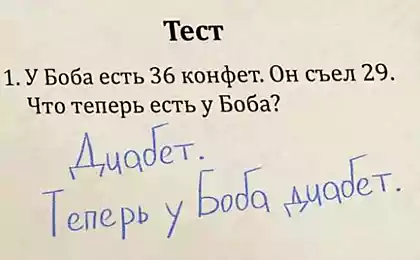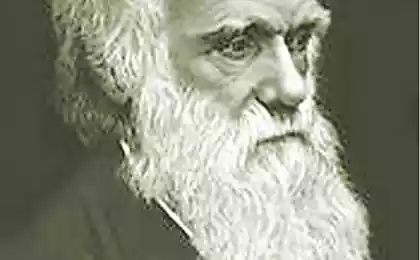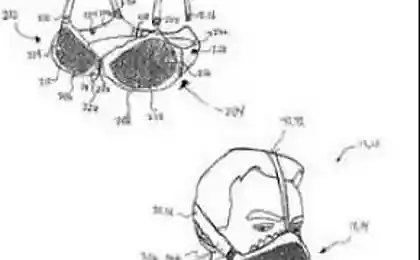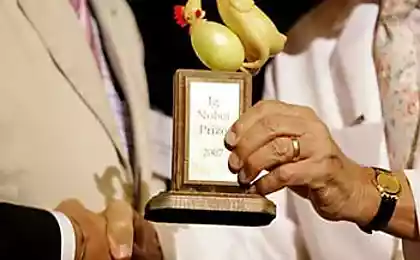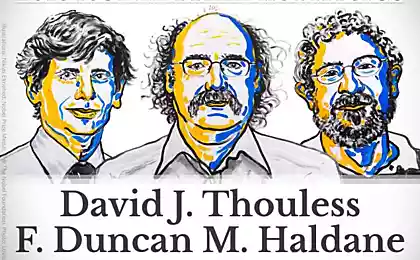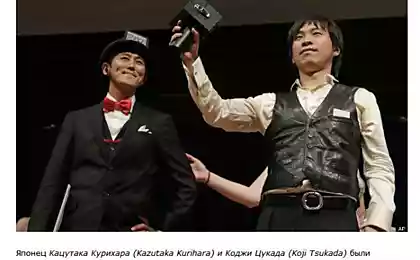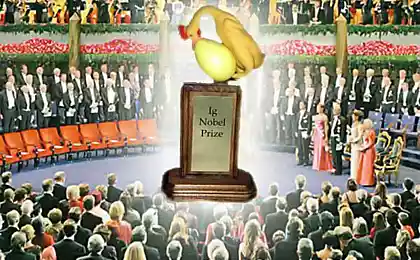587
Winners of the IG Nobel prize 2016
Sixteen million five hundred seventy nine thousand seven hundred seventy one
Thomas Thwaites from the UK has designed an artificial limb, the mountain goats took him. For three days the scientist lived in the herd, eating grass and jumped over the rocks, exploring the habits of wild animals. The IG Nobel prize 2016 biology
22 September 2016 was held the ceremony of the annual IG Nobel prize. As usual, this award goes to scientists for funny, at first glance, the scientific discoveries that "first make you laugh and then make you think". This year the winners received a 10 trillion Zimbabwean dollars. By the way, the Director of the Reserve Bank of Zimbabwe in 2009 was awarded the IG Nobel prize in mathematics.
These discoveries are always fun, but this does not negate their practical value. For example, the effect of Dunning-Kruger (winner of the IG Nobel prize 2000) explains a lot in shaping the social hierarchy of human society. Or take the Association of dead people of India. It protects the rights of poor citizens, which the authorities issued dead to seize their property (the peace prize of 2003), is also quite relevant problem. In other years the awards have been studies indicating that the presence of people sexually arouses ostriches; that black holes on the parameters suitable as the location of hell; checking the urban legend about the five-second rule etc. are All real scientific work published in reputable journals. The IG Nobel prize and take the real Nobel laureates. For example, the Russian-British physicist Andre Geim received her study of the use of magnets for levitation of a frog.

The IG Nobel award in Boston was presented by (left to right): Dudley, Hersbach (Nobel prize in chemistry, 1986), Eric Maskin (Nobel prize in Economics, 2007), Richard Roberts (Nobel prize in medicine, 1993) and Roy Glauber (Nobel prize in physics, 2005). Photo: AP Photo / Michael Dwyer
This year was rich in interesting scientific discoveries. For example, the prize for medicine was given to the team of German scientists for an incredible discovery: if it is scratched on the left side of the body, itching can be alleviated by looking in the mirror and scratching the corresponding location on the right side of the body, and Vice versa (scientific article "Itch Relief by Mirror Scratching. A Psychophysical Study" published in the journal PLoS ONE, vol. 8, no 12, December 26, 2013, e82756).
The award in the field of breeding and reproduction has received Egyptian urologist Ahmed Shafiq, who thoroughly researched, as the wearing of panties made of 100% polyester, 100% cotton, 100% wool and 50/50% cotton/wool affects the sexual life of rats. It turned out that rats, vilified six months briefs polyester, much less active in sex. He suggested that this may be due to the electrostatic charge, which creates the material (scientific paper "Effect of Different Types of Textiles on Sexual Activity. Experimental study" published in the journal European Urology, vol. 24, no. 3, 1993, pp. 375-80).
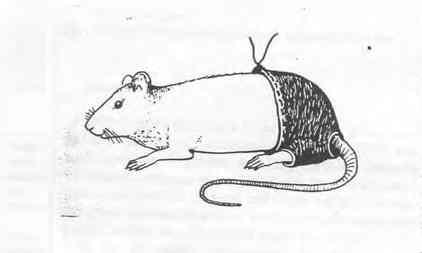
Illustration of scientific articles of Ahmed Shafik
A group of scientists from New Zealand and the UK won the award for fantastic research "brand personality" for example... stones. According to the survey respondents individual stones received specific "characteristics of personality", depending on appearance. For example, the Respondent saw it as "a big businessman from new York, a wealthy, calm, maybe a little suspicious." Another stone, one Respondent assigned the characteristics "of a person leading a nomadic life of a traveler," and another saw "liberal, attractive young woman who had worked as a model, he prefers organic foods". The study has clear practical value from the point of view of marketing, sales and branding of products (scientific article "The Brand Personality of Rocks: A Critical Evaluation of a Brand Personality Scale" published in the journal Marketing Theory, vol. 14, no. 4, 2014, pp. 451-475).
The prize in biology was shared by two Britons: Charles foster, who was the natural way of life at different times as the badger, otter, deer, Fox and bird (in the role of badger Explorer ate worms and was trying to sniff out wolves, as the urban foxes digging out of garbage cans and slept in the courtyards); and his associate Thomas Thwaites for the invention of artificial extensions of the limbs that allowed him to move around the hills to herd goats in the Swiss Alps, where he three days eating grass, bleating and jumping on rocks. Both the inquiring mind wrote books about their experiences (the book "GoatMan; How I Took a Holiday from Being Human", Princeton Architectural Press, 2016, ISBN 978-1616894054; "Being a Beast", Profile Books, 2016, ISBN 978-1781255346).
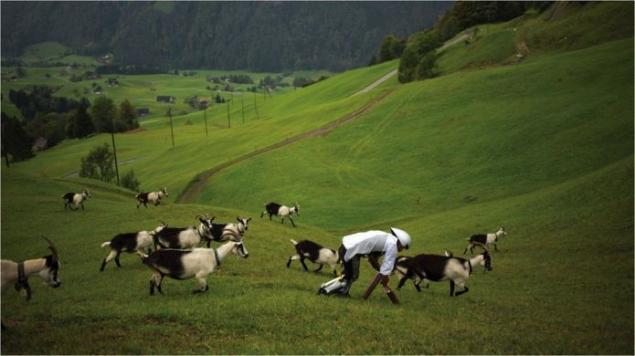
Thomas Twaites with artificial limbs
Once Thomas Thwaites almost got into a fight with other goats. "Well, you know, I was just walking around, munching grass. He raised his head — and suddenly I see that everyone else had stopped to chew, and around me is growing kind of tension that I had not noticed before. There are one or two goats with horns at the ready began to scurry around, clearly intending me to butt. I thought I was fighting them I can't help it," he said in an interview with the BBC.
Scientists from Hungary, Spain, Sweden and Switzerland shared the prize in physics for the discovery that white horses attract fewer insects, and dragonflies that fatally attracted to black tombstones (scientific article "An Unexpected Advantage of Whiteness in Horses: The Most Horsefly-Proof Horse Has a Depolarizing White Coat" published in the journal Proceedings of the Royal Society B, vol. 277 no. 1688, pp. June 2010, pp. 1643-1650; article "Ecological Traps for Dragonflies in a Cemetery: The Attraction of Sympetrum species (Odonata: Libellulidae) by Horizontally Polarizing Black Grave-Stones", published in the journal Freshwater Biology, vol. 52, vol. 9, September 2007, pp. 1700-9).
Award in psychology awarded by an international team of scientists from Belgium, the Netherlands, Germany, Canada and the United States for a large-scale survey of 1,000 liars about how often they lied in the course of life, how professionally it was done, as they improved their skills over the years. It turned out that children lie more as they get older, reaching a peak of deception in adolescence. Adults lie an average of twice a day, and with age, declining, with a few exceptions. Scientists have also quite logically suggested that respondents were able to lie during a survey (the scientific article, "From Junior to Senior Pinocchio: A Cross-Sectional Lifespan Investigation of Deception" published in the journal Acta Psychologica, vol. 160, 2015, pp. 58-68).
The peace prize was taken by the philosophers from Canada and the United States for a scientific treatise entitled "On the perception and recognition pseudoglobulin nonsense". Philosophers have studied how people perceive gibberish that looks meaningful, in the form of random grammatical sentences with clever catchphrases and scientific-sounding terms. Such phrases are intended to hypnotize office workers or to divert the attention of patients the dentist. For example, phrases such as "integrity, whose silence exceeds the the phenomenon of infinity" or "hidden meaning converts incomparable abstract beauty." Scientists believe that the delusional statements, the real logical phenomenon that can be circulated in the modern era of ubiquitous communications and the Internet. As examples, they cite some tweets of famous personalities with millions of followers on Twitter. The question is how people are able to recognize blatant nonsense in the text (scientific article "On the Reception and Detection of Pseudo-Profound Bullshit" published in the journal Judgment and Decision Making, Vol. 10, No. 6, February 2015, pp. 549-563).
All winners of the IG Nobel prize, the audience launched paper airplanes.
The first paper aeroplane launch https://t.co/Lcsh3hCIq0— Improbable Research (@improbresearch) September 22, 2016
The prize for literature went to Sweden, where he lives writer Fredrik Seeberg. He wrote an autobiographical trilogy about his life, which has known the pleasure of collecting dead flies and live flies ("The Fly Trap", the first volume of the autobiographical trilogy "En Flugsamlares Vag". Pantheon Books, 2015, ISBN 978-1101870150).
Prize in chemistry was deservedly taken by the company Volkswagen, which solved the problem of environmental pollution using the original automatic and Electromechanical solutions, which reduce the exhaust emissions during any measurement (report "EPA, California Notify Volkswagen of Clean Air Act Violations" of the Agency for environmental protection of the United States, September 18, 2015).
Finally, the prize in the field of perception received two Japanese researchers to study how changes the perception of size and distance to the subject, if you bend over and look at him in the space between the legs (the scientific article "Perceived size and Perceived Distance of Targets Viewed From Between the Legs: Evidence for Proprioceptive Theory", Higashiyama Atsuki and Kohei Adachi, Vision Research, vol. 46, No. 23, November 2006, pp. 3961-76).
Source: geektimes.ru/post/280766/
Thomas Thwaites from the UK has designed an artificial limb, the mountain goats took him. For three days the scientist lived in the herd, eating grass and jumped over the rocks, exploring the habits of wild animals. The IG Nobel prize 2016 biology
22 September 2016 was held the ceremony of the annual IG Nobel prize. As usual, this award goes to scientists for funny, at first glance, the scientific discoveries that "first make you laugh and then make you think". This year the winners received a 10 trillion Zimbabwean dollars. By the way, the Director of the Reserve Bank of Zimbabwe in 2009 was awarded the IG Nobel prize in mathematics.
These discoveries are always fun, but this does not negate their practical value. For example, the effect of Dunning-Kruger (winner of the IG Nobel prize 2000) explains a lot in shaping the social hierarchy of human society. Or take the Association of dead people of India. It protects the rights of poor citizens, which the authorities issued dead to seize their property (the peace prize of 2003), is also quite relevant problem. In other years the awards have been studies indicating that the presence of people sexually arouses ostriches; that black holes on the parameters suitable as the location of hell; checking the urban legend about the five-second rule etc. are All real scientific work published in reputable journals. The IG Nobel prize and take the real Nobel laureates. For example, the Russian-British physicist Andre Geim received her study of the use of magnets for levitation of a frog.

The IG Nobel award in Boston was presented by (left to right): Dudley, Hersbach (Nobel prize in chemistry, 1986), Eric Maskin (Nobel prize in Economics, 2007), Richard Roberts (Nobel prize in medicine, 1993) and Roy Glauber (Nobel prize in physics, 2005). Photo: AP Photo / Michael Dwyer
This year was rich in interesting scientific discoveries. For example, the prize for medicine was given to the team of German scientists for an incredible discovery: if it is scratched on the left side of the body, itching can be alleviated by looking in the mirror and scratching the corresponding location on the right side of the body, and Vice versa (scientific article "Itch Relief by Mirror Scratching. A Psychophysical Study" published in the journal PLoS ONE, vol. 8, no 12, December 26, 2013, e82756).
The award in the field of breeding and reproduction has received Egyptian urologist Ahmed Shafiq, who thoroughly researched, as the wearing of panties made of 100% polyester, 100% cotton, 100% wool and 50/50% cotton/wool affects the sexual life of rats. It turned out that rats, vilified six months briefs polyester, much less active in sex. He suggested that this may be due to the electrostatic charge, which creates the material (scientific paper "Effect of Different Types of Textiles on Sexual Activity. Experimental study" published in the journal European Urology, vol. 24, no. 3, 1993, pp. 375-80).

Illustration of scientific articles of Ahmed Shafik
A group of scientists from New Zealand and the UK won the award for fantastic research "brand personality" for example... stones. According to the survey respondents individual stones received specific "characteristics of personality", depending on appearance. For example, the Respondent saw it as "a big businessman from new York, a wealthy, calm, maybe a little suspicious." Another stone, one Respondent assigned the characteristics "of a person leading a nomadic life of a traveler," and another saw "liberal, attractive young woman who had worked as a model, he prefers organic foods". The study has clear practical value from the point of view of marketing, sales and branding of products (scientific article "The Brand Personality of Rocks: A Critical Evaluation of a Brand Personality Scale" published in the journal Marketing Theory, vol. 14, no. 4, 2014, pp. 451-475).
The prize in biology was shared by two Britons: Charles foster, who was the natural way of life at different times as the badger, otter, deer, Fox and bird (in the role of badger Explorer ate worms and was trying to sniff out wolves, as the urban foxes digging out of garbage cans and slept in the courtyards); and his associate Thomas Thwaites for the invention of artificial extensions of the limbs that allowed him to move around the hills to herd goats in the Swiss Alps, where he three days eating grass, bleating and jumping on rocks. Both the inquiring mind wrote books about their experiences (the book "GoatMan; How I Took a Holiday from Being Human", Princeton Architectural Press, 2016, ISBN 978-1616894054; "Being a Beast", Profile Books, 2016, ISBN 978-1781255346).

Thomas Twaites with artificial limbs
Once Thomas Thwaites almost got into a fight with other goats. "Well, you know, I was just walking around, munching grass. He raised his head — and suddenly I see that everyone else had stopped to chew, and around me is growing kind of tension that I had not noticed before. There are one or two goats with horns at the ready began to scurry around, clearly intending me to butt. I thought I was fighting them I can't help it," he said in an interview with the BBC.
Scientists from Hungary, Spain, Sweden and Switzerland shared the prize in physics for the discovery that white horses attract fewer insects, and dragonflies that fatally attracted to black tombstones (scientific article "An Unexpected Advantage of Whiteness in Horses: The Most Horsefly-Proof Horse Has a Depolarizing White Coat" published in the journal Proceedings of the Royal Society B, vol. 277 no. 1688, pp. June 2010, pp. 1643-1650; article "Ecological Traps for Dragonflies in a Cemetery: The Attraction of Sympetrum species (Odonata: Libellulidae) by Horizontally Polarizing Black Grave-Stones", published in the journal Freshwater Biology, vol. 52, vol. 9, September 2007, pp. 1700-9).
Award in psychology awarded by an international team of scientists from Belgium, the Netherlands, Germany, Canada and the United States for a large-scale survey of 1,000 liars about how often they lied in the course of life, how professionally it was done, as they improved their skills over the years. It turned out that children lie more as they get older, reaching a peak of deception in adolescence. Adults lie an average of twice a day, and with age, declining, with a few exceptions. Scientists have also quite logically suggested that respondents were able to lie during a survey (the scientific article, "From Junior to Senior Pinocchio: A Cross-Sectional Lifespan Investigation of Deception" published in the journal Acta Psychologica, vol. 160, 2015, pp. 58-68).
The peace prize was taken by the philosophers from Canada and the United States for a scientific treatise entitled "On the perception and recognition pseudoglobulin nonsense". Philosophers have studied how people perceive gibberish that looks meaningful, in the form of random grammatical sentences with clever catchphrases and scientific-sounding terms. Such phrases are intended to hypnotize office workers or to divert the attention of patients the dentist. For example, phrases such as "integrity, whose silence exceeds the the phenomenon of infinity" or "hidden meaning converts incomparable abstract beauty." Scientists believe that the delusional statements, the real logical phenomenon that can be circulated in the modern era of ubiquitous communications and the Internet. As examples, they cite some tweets of famous personalities with millions of followers on Twitter. The question is how people are able to recognize blatant nonsense in the text (scientific article "On the Reception and Detection of Pseudo-Profound Bullshit" published in the journal Judgment and Decision Making, Vol. 10, No. 6, February 2015, pp. 549-563).
All winners of the IG Nobel prize, the audience launched paper airplanes.
The first paper aeroplane launch https://t.co/Lcsh3hCIq0— Improbable Research (@improbresearch) September 22, 2016
The prize for literature went to Sweden, where he lives writer Fredrik Seeberg. He wrote an autobiographical trilogy about his life, which has known the pleasure of collecting dead flies and live flies ("The Fly Trap", the first volume of the autobiographical trilogy "En Flugsamlares Vag". Pantheon Books, 2015, ISBN 978-1101870150).
Prize in chemistry was deservedly taken by the company Volkswagen, which solved the problem of environmental pollution using the original automatic and Electromechanical solutions, which reduce the exhaust emissions during any measurement (report "EPA, California Notify Volkswagen of Clean Air Act Violations" of the Agency for environmental protection of the United States, September 18, 2015).
Finally, the prize in the field of perception received two Japanese researchers to study how changes the perception of size and distance to the subject, if you bend over and look at him in the space between the legs (the scientific article "Perceived size and Perceived Distance of Targets Viewed From Between the Legs: Evidence for Proprioceptive Theory", Higashiyama Atsuki and Kohei Adachi, Vision Research, vol. 46, No. 23, November 2006, pp. 3961-76).
Source: geektimes.ru/post/280766/
The most fashionable tendencies of a season autumn-winter 2017!
From a sedentary lifestyle dies to 433 thousand people a year


